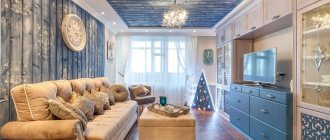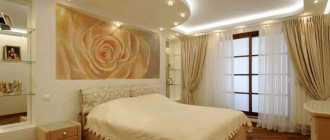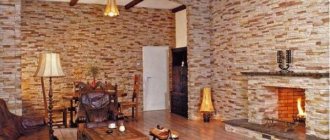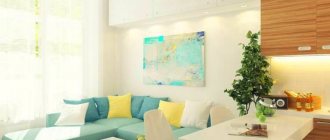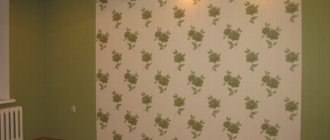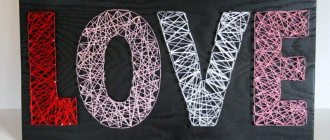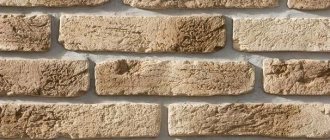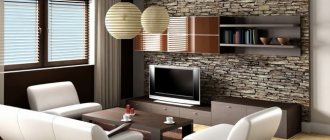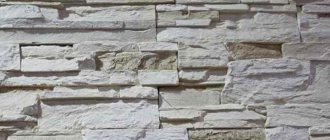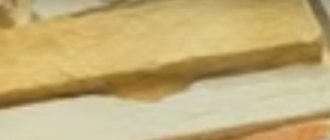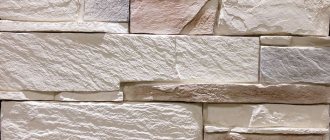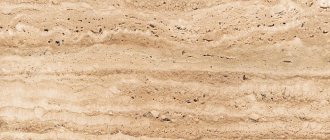Advantages of artificial stone in design
- Stone tiles withstand mechanical stress well. A variegated pattern and dark shades will help maintain a presentable appearance of the sections of walls around the door, sockets and mirrors for a long time.
- Stone is always perceived as an elite material. Therefore, it easily fits into luxury apartments in a classic style.
- Modern ethnic design trends readily use stone finishing in measured quantities.
- High-quality stone imitation helps to fit photo wallpaper with a deep perspective into the interior (windows, terraces, patios, etc.).
- Mirrors benefit from this proximity, since the rough surface absorbs excess glare.
- Decorative stone is fireproof.
- Does not emit toxic substances, safe for health.
- The material can withstand large temperature changes, which allows it to be used in the kitchen.
- Resistant to mold and mildew.
Combination of stone with other finishing options
The assumption that stone texture is difficult to combine with other finishing options is nothing more than a misconception. Marble, granite, brickwork are ideally combined not only with wallpaper.
Decorative stone with wallpaper
Since the kitchen space is usually quite small, to avoid the “dungeon” effect, allocate a minimum area to the mineral. Work area or countertops – it doesn’t matter. The main thing is to play on contrasts when combining with wallpaper: if the texture of the mineral is dark, it is advisable to select wallpaper in light colors. Ideally, wallpaper should be plain or imitate natural materials.
When combining with wallpaper, it is important to take into account the rigidity of the decorative part of the wall: plaster imitation is much easier to cut to the desired shape. And when working with acrylic or colored concrete, you should attach them to the wall last.
Decorative stone with photo wallpaper
The combination allows you to show maximum creativity and create a “destroyed wall” effect. Decorate not only the apron with colored brick or agglomerate, but also the wall opposite. And on the very opposite wall, insert any picture you like on the photo wallpaper. Not only will it all look simply amazing, but there will also be an effect of expanding the space.
Stone wall with paint
Painted walls will help remove the visual congestion of the space, and masonry will allow you to place accents where they are needed. The main rule is not to use paint that matches the stone.
With plaster
One of the most winning options. With this approach, the kitchen design will not only be creative and unique, but also environmentally friendly. Venetian, also known as decorative plaster, will give the walls a stone-like appearance, creating a common, complete tandem of textures.
In this case, it is important not to visually overload the walls - no matter what the decorative stone is, the color of the finishing layer of mortar should be soft and not irritating to the eye. The same approach will help to visually expand the walls of the kitchen space.
Features you need to know
In conditions of limited space, it is advisable to lay stone tiles in fragments. Otherwise, the effect of a dungeon or monastic cell will be created.
Spacious hallways in private mansions and cottages can afford to use an accent wall decorated with stone tiles instead of individual fragments. It should be taken into account that thin plasterboard partitions are not able to withstand the impressive load from full-weight sandstone or granite. In this case, it is better to use high-quality gypsum imitations. They are no less expressive and unusually light.
You should also carefully use natural stone when designing semicircular arched spans. Give preference to either thinly sliced slabs or gypsum tiles. Cement imitations can also be used. In any case, take into account the weight of the decorative material and the strength of the frame located inside the partitions.
Proper lighting plays an important role, which can completely depersonalize the texture of the stone or reveal it in all its glory. Front rays provide a minimum of shadows and smooth out the wall topography. Lamps that direct the flow of light from above and below allow you to create a play of shadows that reveals the volume and texture of each tile. Lighting must be thought out carefully so that each spot and sconce work for the overall result.
Varieties
When choosing decorative stone finishing, keep in mind that it can be not only artificial, but also natural.
Fake diamond
Artificial stone usually means colored concrete brick, agglomerate or porcelain stoneware. The latter is most often preferred when tiling the floor, window sill and work area. Thanks to porcelain stoneware, the surface acquires an elegant, noble, monumental appearance.
The agglomerate is used to accurately imitate the structure of natural minerals. For the most part, it is preferable for cladding kitchen aprons and walls.
Colored concrete bricks are usually made by mixing sand, cement, aggregates and color pigment. It is ideal for achieving the effect of brickwork or stone walls.
A natural stone
If desired, you can use exclusively natural materials; you can decorate the kitchen with quartzite, granite, marble, travertine. The first thing to consider is the price range: natural finishes will cost many times more than artificial decorative ones.
Combination of stone tiles and wallpaper
The stone goes well with all types of plaster, decorative putty, paint and wallpaper.
Since stone decor is quite expensive and labor-intensive, wallpaper provides an opportunity to reduce costs and speed up repairs.
Why stone?
Long used in interior design, decorative stone is increasingly included in kitchen design. Attractive properties include:
- Environmentally friendly. This characteristic is one of the most important for a place where food is constantly stored and food is prepared.
- Durability. The cladding made with this material will not lose its appearance for many years. At the same time, it will not require cosmetic repairs, will not crumble or crack. The resulting surface is not susceptible to scratches and chips.
- Variety. Decorative involves a range of colors and a large selection of textures. With its help you can obtain an absolutely smooth, glossy surface, make it matte and embossed. It fits well into any interior and goes well with other finishing materials.
- Lack of labor-intensive care. Since it has antistatic properties, it eliminates the attraction of dust. Its resistance to moisture and aggressive environments makes it possible to clean it by any means without fear for the preservation of its appearance.
- Easy to install. Cladding with decorative stone does not require any special skills. Installation can be done with your own hands, without specialists. The material forgives inaccuracies. Often a mistake can turn into an original design solution.
- Versatility. When laying this material, complex preparatory work is not necessary. In turn, decorative stone allows you to hide flaws in repairs and uneven walls.
Has long been used in interior decoration
To all this should be added the non-flammability of the material, as well as the ability to withstand high temperatures. This property is especially important for rooms where there is an open fire.
Advice When purchasing a decorative stone, pay attention to its geometry, the absence of through holes and individual textures with dimensions larger than 5 mm.
Loft
The loft deliberately shows the material of the walls, the industrial filling of old industrial premises, converted into residential apartments and houses.
A piece of wall that the builders “forgot” to plaster and wallpaper will serve as the basis for a light hanger model.
The red brick that frames the mirror will remind you of the era of construction booms. This style is generally characterized by the use of thin tiles imitating brick and natural stone in combination with modern wallpaper of moderate colors and calm tones.
Interior decoration
How to use artificial stone to create an original interior in your home? Fortunately, this material is in harmony with almost all other materials.
used in the home: wood, metal, glass or fabric.
In addition, its use is appropriate for creating any style
: you just need to successfully select the surface texture of the material and its color.
For a classic style, for example, calm tones are more suitable. For more modern styles, such as modern, artificial stone will also be quite appropriate. Rich contrasting colors are suitable here.
Minimalist style and hi-tech also welcome this practical and beautiful material. The “country” style will require the use of brown or beige tones, and the Mediterranean style will require milk and cream tones.
It is very fashionable to clad fireplaces and bar counters with decorative stone.
.
When it comes to fireplaces, you don’t have to worry about the tiles being damaged by high temperatures.
It is only important to choose the right glue
This finish will add strength to the bar counter. Everything where artificial stone is used becomes refined, noble and extremely beautiful.
.
We advise you to study - Master class: how to make a figured headboard of a bed
What else is worth considering?
The main rule: finishing surfaces with decorative stone should be in harmony with the overall design of the room.
There is no need to cover large areas, and it will be unnecessary. The abundance of stone in the room does not decorate it, but rather makes it look like a cave. This environment is depressing.
Separate stakes made of stone will look much more original. It can be:
- parts of walls;
- ceiling fragments;
- niches;
- shelves;
- racks;
- podiums.
If you use relief light tiles, you will get a medieval effect. Flights of stairs or decorative columns lined in this way will look solemn. All this will give a majestic, rich look to the interior and create a feeling of security.
Decorative stone can also play a big role in improving the garden area. For example, they can be used to decorate fountains and small ponds in the yard. It looks extremely stylish and fascinating.
In the apartment, in addition to the listed places of decoration, this artificial material can also find its use when decorating a loggia or balcony.
Wherever you decide to use artificial stone, it can truly beautify your home.
Nowadays, the building materials market provides almost unlimited possibilities for creating an interior to suit every taste. Decorative stone in the kitchen interior allows you to create an exquisite interior design and feel like an inhabitant of a medieval castle. The use of artificial stone on the walls not only gives a visual effect, but also creates the feeling of touching real stone.
The following types of artificial material are used in interior design:
- sandstone;
- Traverine;
- river stone;
- slate;
- limestone.
Provence
Despite the fact that this style gravitates more toward wooden boards, clay, lime whitewash and light pastel colors, there is always a place for stone in a Provencal interior.
Choose light colors and large blocks. Sometimes it is possible to combine tiles that imitate white brick and wood well.
The stone is good with elegant fine forging. It works great in tandem with stylish wrought iron sconces. Wall lighting will provide light shadows that highlight the voluminous texture of the tiles.
Advantages and disadvantages
The main advantages of decorative stone include the following parameters:
- A large selection of shades - a huge color palette allows you to create the most incredible decorative surfaces from this material. If desired, you can arrange a glossy or matte kitchen apron, with a uniform texture or multi-colored splashes. Using artificial decorative stone, they effectively imitate natural materials: marble, quartz, granite, volcanic rocks. No less popular are plain panels in neutral shades - anthracite, gray, beige, white, cream, pastel. If desired, you can also make a colored apron from artificial stone.
- Smooth connection of the apron to the tabletop and the absence of seams - this material allows you to create perfectly flat and smooth surfaces without joints.
- Monolithic dense structure - this material has no pores, so it is not able to absorb moisture, grease, dirt and other contaminants. Fungi, bacteria and other microorganisms do not multiply on a smooth surface. In addition, it is very easy to care for - just wipe it periodically with a damp sponge using traditional detergents.
- Ease of restoration - if suddenly an apron made of such stone is damaged, it can be easily restored. To do this, you don’t need to change the entire apron. In addition, scratches that appear over time can be easily removed from such a surface - you just need to sand it well, and the apron will look like new.
- If desired, an apron made of decorative stone can be complemented with a window sill, bar counter and kitchen sink in the same tone, made of the same material. Such an interior will look very harmonious, stylish and respectable.
Decorative stone has disadvantages, but they are few. These include its high cost. However, it should be understood that the price of the material is quite justified, given its quality and external characteristics.
Decorative stone also has considerable weight, which makes its installation somewhat difficult; this material also places a significant load on the walls.
We advise you to study - What to choose - a bathtub or a shower
In addition, some types of decorative stone are quite sensitive to high temperatures and chemical influences.
It's always interesting to peek through a crack
A mirrored cabinet and a photo print framed in stone will allow you to be transported to the Mediterranean and feel like an archaeologist. Glue gypsum tiles imitating marble or limestone on top of the photo wallpaper. Imagine the composition as a gap in an ancient wall, through which the walls of the old city are visible or a view of the seascape opens up. The view of the winding streets “running away” into the distance is also good.
Stone tiles allow you to make a beautiful transition to the image and add realism to the picture.
Features of material care
Natural facing stone has the least practical maintenance requirements. This coating is quite easy to wash and remove dirt with a brush and detergents. Particular attention should be paid to joints and nicks, where greasy deposits, soot, and dirt can accumulate.
Regarding artificial finishing material, there are a number of care features:
- Before purchasing a stone, you should carefully study the composition and presence of a protective coating (varnish).
- If there is no industrial impregnation of synthetic stone, you must do it yourself, using acrylic varnish or specialized compounds.
Otherwise, the secrets of caring for finishing materials are as simple as in the case of natural stone.
Corners and arches
Corners and arches experience particularly powerful mechanical stress. This is where wallpaper likes to peel up and stains appear.
The area above the baseboard is subject to pressure from the claws and teeth of pets and wet children's boots.
Stone and porcelain tiles help to maximize the durability of fresh renovations, because... They are resistant to stains and retain their color and shape for a long time.
Types of stone
A common feature for all types of decorative stone is uniqueness. Each coating is unique. The material used in finishing work can be of natural or artificial origin.
Natural
This view is created by nature. The role of a person in preparing it for finishing use comes down to mining, sorting and giving the stone the required shape. This material is believed to have vital energy and even improve health. In cold weather it creates comfort and retains accumulated heat for a long time, and in hot weather it provides coolness. The durability of natural stone is estimated at many decades .
A highlight that will add variety to the interior
Granite is used to decorate the kitchen, bringing sparkles and shimmer . Marble brings rigor and nobility to the interior. Travertine fills the kitchen with light and promotes a good mood. River pebbles bring coolness and distract from problems. Slate creates a homely effect and resembles a hearth, while sandstone and limestone provide warmth.
When choosing natural decorative stone for kitchen decoration, you need to prepare for serious costs.
Artificial
The finishing material belonging to this group is only partly artificial, since the lion's share in its composition is occupied by the same natural material, represented by crumbs and sand.
In terms of characteristics, artificial decorative stone is not much different from its natural counterpart. Additives that act as a gluing material do not impair environmental performance, and in some cases make it possible to achieve greater strength and wear resistance from the material. It is lightweight and outperforms natural ones in terms of economy.
Will add comfort to the interior
Niches
Stone niches look good in classic, Provence and loft styles. Here you can place a mirror or several shelves for gloves, keys and hats.
But the special chic is the art gallery in improvised niches framed in precious stone. This idea can be easily implemented in country cottages. For Soviet-era apartments, such an idea is only possible if there is an adjoining long corridor.
Stonework above the bar
It is not at all necessary to completely decorate the wall panels with stone. Sometimes it is enough to highlight only one part of the wall, for example, above the bar counter. This approach gives the kitchen a special style, combining notes of antiquity and classicism. Along the contour of the masonry, you can place rails and hooks for dishes, lighting fixtures and storage systems.
Decorating the walls in the hallway and kitchen with decorative stone and wallpaper in the photo (real examples):
The combination of wallpaper and stone looks elegant, and with skillful design can produce a striking effect on guests. Especially in combination with design styles such as loft, Provence and Mediterranean.
Mar 4, 2017Werri
How to decorate a balcony with stone yourself?
There are two main finishing methods: with jointing and seamless, in which decorative elements are laid so that there is no space left between the joints
This method requires professionalism: it is important that the glue does not leak out of the seam.
Step-by-step instructions for wall cladding
Beginners can also do laying with jointing:
- First, the walls are leveled and cleaned.
- If a pattern is planned on the walls, it is recommended to lay out the tiles on the floor in order to combine them in advance.
- According to the instructions, glue is prepared.
- The glue is applied to the wall using a comb, then onto the decorative material. Products should be laid from top to bottom: cutting is usually done from the floor. Each fragment is glued to the wall using light pressure.
DIY finishing video tutorial
This video tells you more about decorating your balcony yourself:
Do-it-yourself stone wallpaper: what subtleties you should know
You can make stone wallpaper yourself thanks to the appearance of flexible natural stone on the market. Flexible stone is so named because it can take any shape. They can decorate any part of the house, both floor and ceiling. Flexible stone is safe for health and looks extremely aesthetically pleasing in interior decoration.
Making stone wallpaper is not difficult and you can do it yourself
Flexible stone has a number of features:
- It is elastic;
- It is light;
- It can withstand high temperatures;
- Sold in rolls;
- Flexible house sheets can transmit light, which gives them additional design possibilities;
- Flexible stone is durable: its service life is about 40 years.
Related article: Photo wallpaper Paris: romantic interior
To make stone wallpaper, you should take a roll of flexible stone, tools, glue for light-colored ceramics, and a protective coating. The sheets of the roll must be laid so that the pattern is solid.
Choosing ceramic tiles
You should decide on a purchase for kitchen tiling after you are completely confident in the choice of design. Only after a complete determination of the color scheme, pattern and cladding plan can we proceed to the next stage. You should accurately measure the dimensions of the area to be tiled and calculate the amount of material needed. Do not forget that the design of ceramic tiles should be successfully combined with kitchen furniture and other decorative elements.
This is clearly shown in the photo.
Also in this photo.
When purchasing material, try to buy a little more than the dimensions of the surface being treated indicate. The fact is that you will definitely have to cut the tiles; there will be trimmings that are not suitable for further use. Their area should be excluded. And if you buy tiles back to back, it may happen that you have to buy more.
Important! You should buy ceramic tiles with a reserve - plus 10% of the calculated area.
There is no need for extra tiles either. You should take a serious approach to calculating the required finishing material.
Color palette
When planning the design of a kitchen, the choice of color for it plays an important role. The future design of the room depends on the color palette:
- Snow-white. To expand the kitchen space, a white shade is used. White artificial stone, for example, imitation quartzite, granite or marble, is perfect for classic or Mediterranean interiors. This design would be ideally combined with a natural wooden floor or wall panels made of the same material.
- Black. This color of stone can give the kitchen not only charm, but also depth. It is worth noting right away that black color solutions are suitable for tiling spacious kitchens and are best combined with light shades.
- Grey. When gray and neutral colors are combined in the kitchen interior, the result is a laconic, stylish interior that can claim to be the most fashionable.
- Red. Here we are talking about a shade close to the color of onyx, granite or brick. This solution will undoubtedly attract attention and will be combined with dark wood or stone countertops.
- Brown. This shade is natural, so it perfectly decorates the kitchen. It goes well with wood and brings a touch of homeliness and comfort to the kitchen.
- Beige. This light color is best combined with dark shades to show the contrast of the design. And beige finishing in the kitchen with artificial stone can become an accent for placing a set.
- Colored stone. To create a bright kitchen, use multi-colored artificial stone with tints. A wall or other surface decorated in this way will attract curious glances and become the main highlight of the room.
A little about beauty: what stone wallpapers contain
Stone wallpaper in the interior is a desirable decoration, but what are they? Stone-effect wallpaper is an artificial, thinnest decorative stone that is safe for health from an environmental point of view. Stone wallpaper is made in the form of slabs, approximately 16 mm thick.
Many people prefer to choose stone wallpaper for wall decoration because it is not only cheap, but also easy to apply
Stone wallpaper has a number of advantages:
- They are easy to glue;
- They serve for a long time;
- They are relatively cheap.
Stone wallpaper has a very elegant look, regardless of the color and size of the tile. They look very advantageous in small rooms because they do not reduce the space. Stone wallpaper boasts quality and durability that may not be available in some other types of wallpaper. Wallpaper has good sound and heat insulation.
Separately, it is worth mentioning the production of wallpaper tiles. It can be made independently or in a special production facility. The production of tiles for stone wallpaper is accessible to anyone and does not eat up much of the budget. If desired, established production can be turned into a profitable business.
You can stylishly decorate the interior of your living room by finishing one wall with artificial stone.
The tiles are made from gypsum stone, which then needs to be painted. It is easy to paint; there is a wide range of colors and methods for painting gypsum stone.
Gluing stone wallpaper is very simple. Many people worry about how one tile will fit into another. The whole point is that the size of a particular tile can be adjusted by cutting, sawing, grinding and other methods. Due to their small thickness, the tiles easily adhere to corners, eliminating the need to use corner pieces. To glue the wallpaper to the wall, just use strong glue; you don’t need to take any special tools.
Related article: Do-it-yourself slopes from sandwich panels (video and photos)
Choice of style and color
Let us preface the choice of style and color with some comments. The kitchen is an integral part of the home. It is desirable that it fits into its overall flavor. In addition, the kitchen is the place where the Russian family traditionally spends a significant portion of its time. When choosing a style and color scheme, this is worth taking into account. And finally, finishing an apartment or house is a costly and troublesome process. It is advisable to do it “once and for a long time.” Let's look at popular styles:
- classic is a historical style that arose in Europe in the 17th century, and is distinguished by noble strictness of lines, symmetry, elegance, and harmony;
- loft - originates from the refurbishment of industrial premises, which involves large windows, walls made of unplastered brick, “technogenicity”;
- eco style - emphasizes closeness to nature, which is expressed by the use of natural materials and the use of plants in the interior;
- chalet - originated in the French Alps, the style is characterized by some deliberate roughness;
- country - a rustic style that gained popularity about half a century ago, its principle is “modest, but tasteful”;
- modern style - functionality and practicality, minimalism, simplicity, ignoring established patterns.
As for the color scheme, it would be most correct to say that it can be anything. Among the colors accepted in the design:
- white;
- black;
- gray;
- red;
- brown;
- beige
There is no color in which it would be impossible to create a successful design project. At the same time, there are certain mass preferences. So, it is unlikely that pure black will be a good solution. At the same time, as an element, it is quite appropriate in a modern style. Can be used in a loft. Country and chalets are characterized by faded shades of white, gray, and beige. In eco style, the appearance of green is logical.
